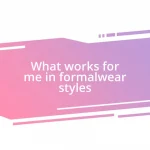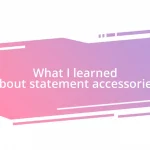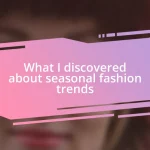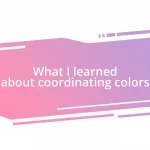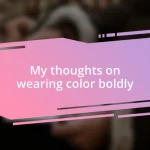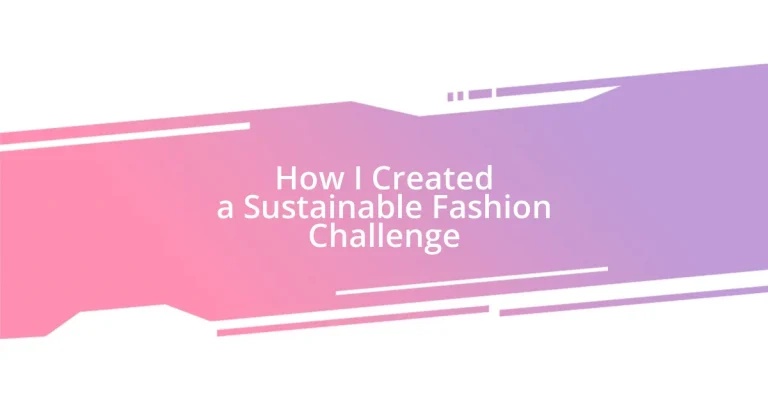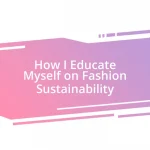Key takeaways:
- Sustainable fashion promotes mindful consumption and emphasizes the importance of slow fashion, encouraging individuals to purchase intentionally and creatively utilize existing wardrobe pieces.
- Engaging with a community through challenges and sharing experiences fosters a supportive network focused on sustainability, enhancing motivation and learning from one another’s journeys.
- Choosing eco-friendly materials and sharing stories behind clothing items deepens personal connections to fashion and highlights the positive impact of sustainable practices on the environment.
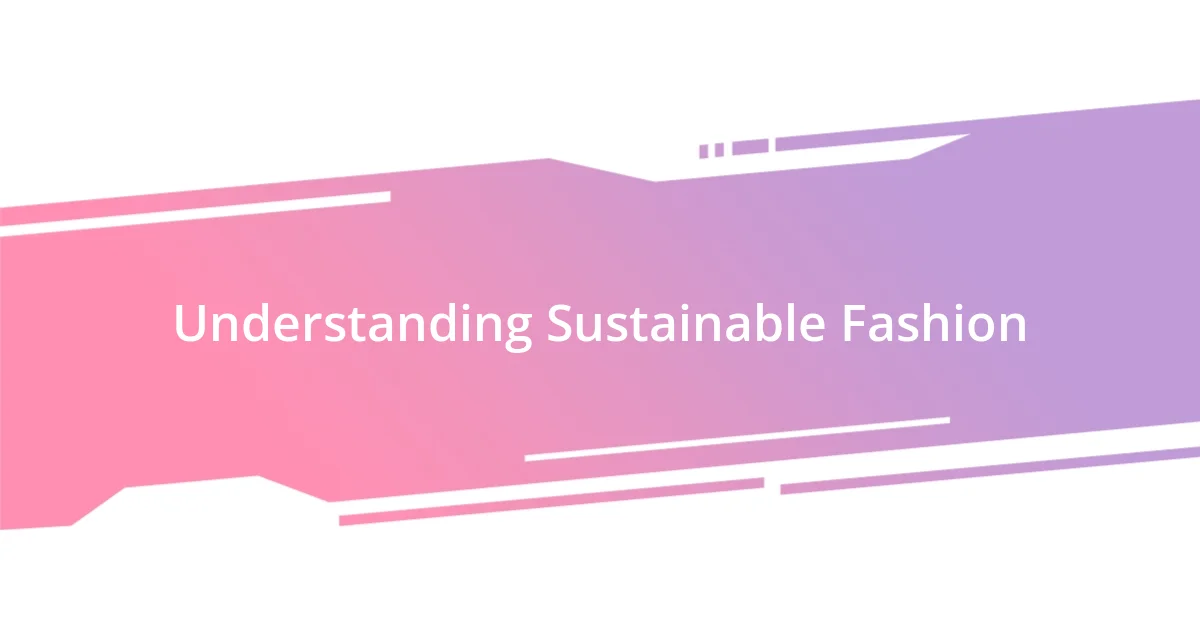
Understanding Sustainable Fashion
Sustainable fashion is more than just a trend; it’s a movement towards a more responsible way of dressing. I remember attending a thrift store event where I found a vintage jacket that sparked conversations about the impact of fast fashion. It made me think: how many pieces in our wardrobe come with a hidden cost to the planet?
When I first started exploring sustainable fashion, I was amazed by the diversity of materials out there. From organic cotton to recycled fabrics, these choices are not just eco-friendly—they tell a story. I often wonder, how can we support brands that prioritize sustainability while still embracing our unique style?
This journey has also opened my eyes to the importance of slow fashion, which encourages mindfulness in our purchasing decisions. I’ve felt the thrill of shopping less frequently but with greater intention, and it’s incredibly fulfilling. Have you ever experienced that moment when you realize a single garment can serve multiple purposes? It’s like discovering a hidden treasure in your closet!
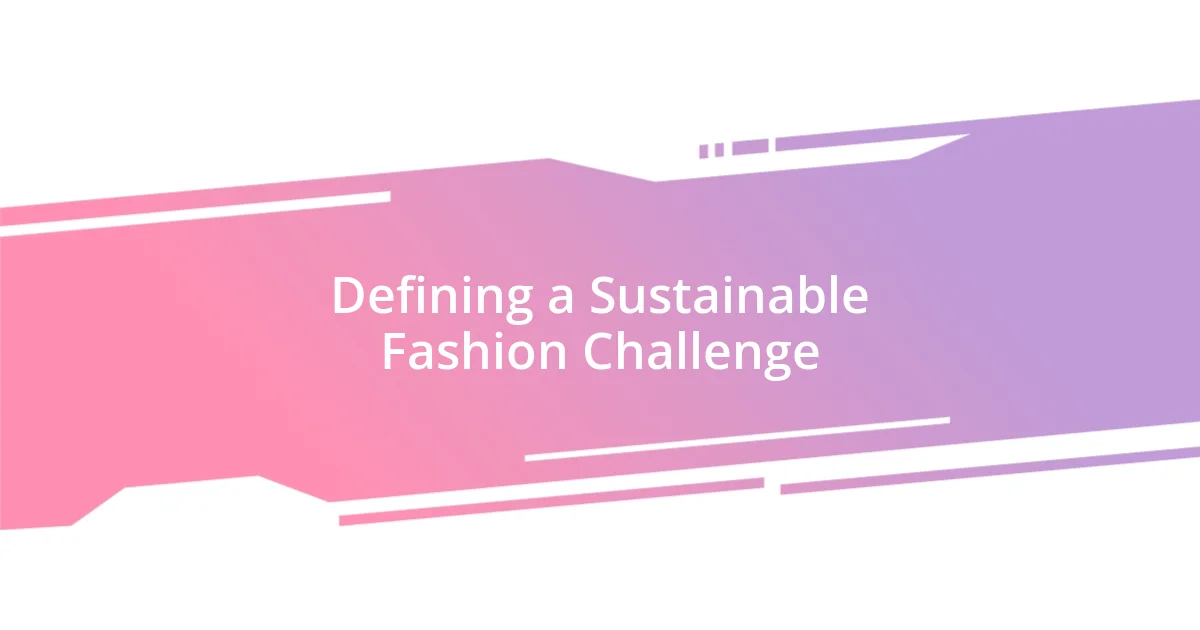
Defining a Sustainable Fashion Challenge
Defining a sustainable fashion challenge involves setting specific goals that encourage individuals to rethink their relationship with clothing. For me, it was about not only understanding the environmental impact of my fashion choices but also inspiring others to join the journey. While participating in a local challenge, I found that sharing my experiences through social media connected me with like-minded individuals, fostering a supportive community.
Here are some essential components to consider when defining a sustainable fashion challenge:
- Duration: Decide how long the challenge will last, whether it’s a week, month, or even a season.
- Goals: Set clear, actionable objectives like reducing your wardrobe size, swapping clothes, or wearing only thrifted items.
- Engagement: Encourage participants to share their experiences, which can amplify motivation and accountability.
- Educational Element: Include information about the impact of fast fashion to deepen participants’ understanding.
- Inclusivity: Make sure the challenge is accessible to everyone, regardless of their current wardrobe situation or budget.
Reflecting on my own experiences, I discovered that facing challenges head-on, like committing to a month without shopping, shifted my perspective significantly. It transformed not just my closet but also how I viewed the very essence of fashion—turning it into a form of personal expression and sustainability advocacy.
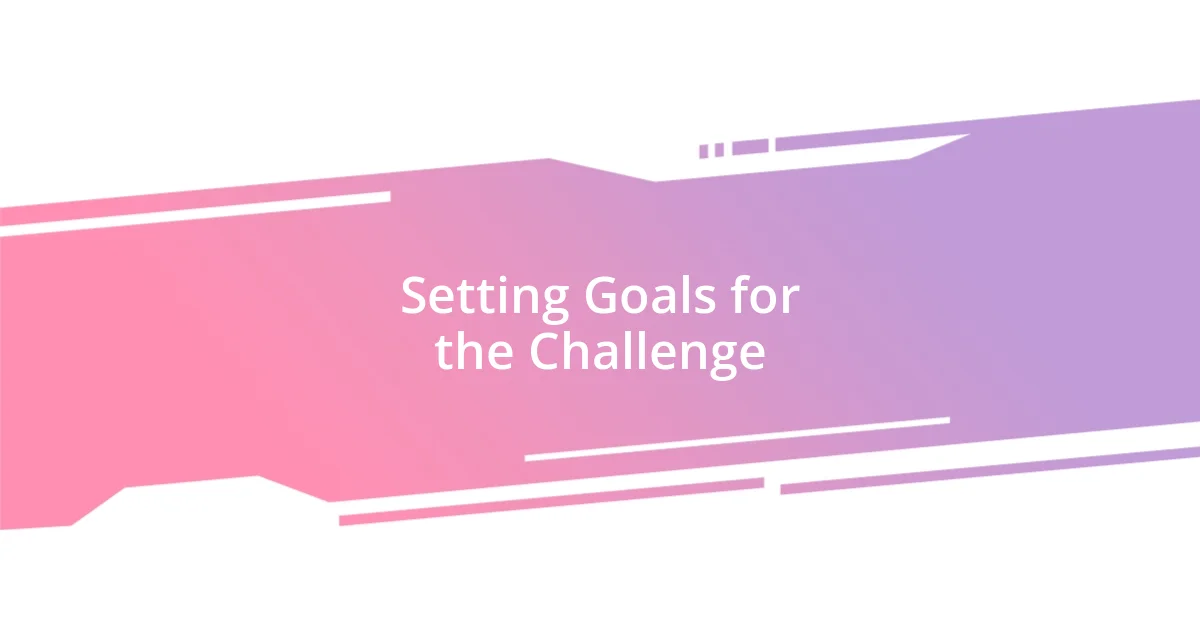
Setting Goals for the Challenge
Setting goals for a sustainable fashion challenge requires careful thought and personal reflection. My first step was defining my primary objective: reducing my clothing purchases. This goal created a solid foundation for my challenge and pushed me to dig deeper into my wardrobe. Have you ever realized how many clothes you might not even wear? It’s eye-opening to see how one could rely on creativity rather than consumerism.
Next, I established measurable milestones to track my progress. Each week, I committed to styling pieces in my wardrobe differently or discovering new ways to upcycle old garments. I vividly recall the satisfaction I felt after transforming an outdated shirt into a trendy tote bag. It made me appreciate the journey of sustainable fashion even more. In my view, integrating milestones not only encourages accountability but also adds an element of fun to the challenge.
Finally, I prioritized making my goals inclusive. I remember inviting friends with varying budgets and wardrobe sizes to join the challenge. It fostered a sense of community where we shared tips, eco-fashion finds, and even DIY projects. Our diverse backgrounds enriched the experience, showing that sustainable fashion can be for everyone. So, how can you make your challenge more inclusive? I’d say, encourage dialogue and celebrate every small win together!
| Goal | Description |
|---|---|
| Reduce Purchases | Commit to buying less clothing over a defined period. |
| Track Progress | Set measurable milestones to gauge improvement and creativity. |
| Encourage Inclusivity | Invite others to participate, regardless of their fashion background. |
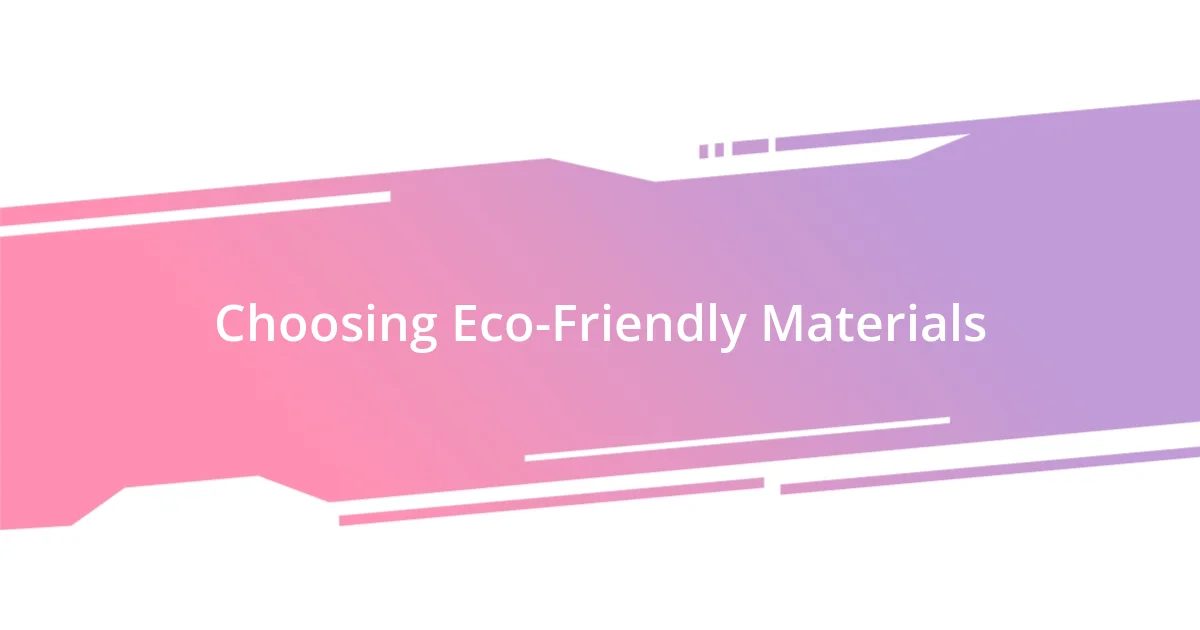
Choosing Eco-Friendly Materials
Choosing eco-friendly materials was one of the most enlightening aspects of my sustainable fashion challenge. I remember feeling overwhelmed by the choices available. I started with organic cotton, which feels lovely against the skin and uses fewer pesticides in its production. Have you ever touched a fabric and immediately felt its quality? That was my experience with organic materials – a tangible reminder of what sustainability can offer.
Additionally, I discovered the beauty of recycled fibers. Incorporating materials like rPET (recycled polyethylene terephthalate) into my wardrobe not only helped reduce waste but also sparked conversations with friends. When I wore a jacket made from recycled plastic bottles, I couldn’t help but feel a sense of pride. Has wearing something sustainable ever made you feel like you were advocating for a cause? For me, it was empowering to see how my fashion choices could inspire dialogue about environmental responsibility.
Exploring natural dyes was another eye-opening journey. I vividly recall a workshop where we used avocado pits to create a beautiful pink hue. It was fascinating to realize how vibrant colors could come from everyday items. The connection to nature was profound, reminding me that fashion can be both artistic and sustainable. How often do we stop to think about the origin of the colors that adorn our clothes? It’s these experiences that truly deepen our understanding of eco-friendly materials and their positive impact on our planet.
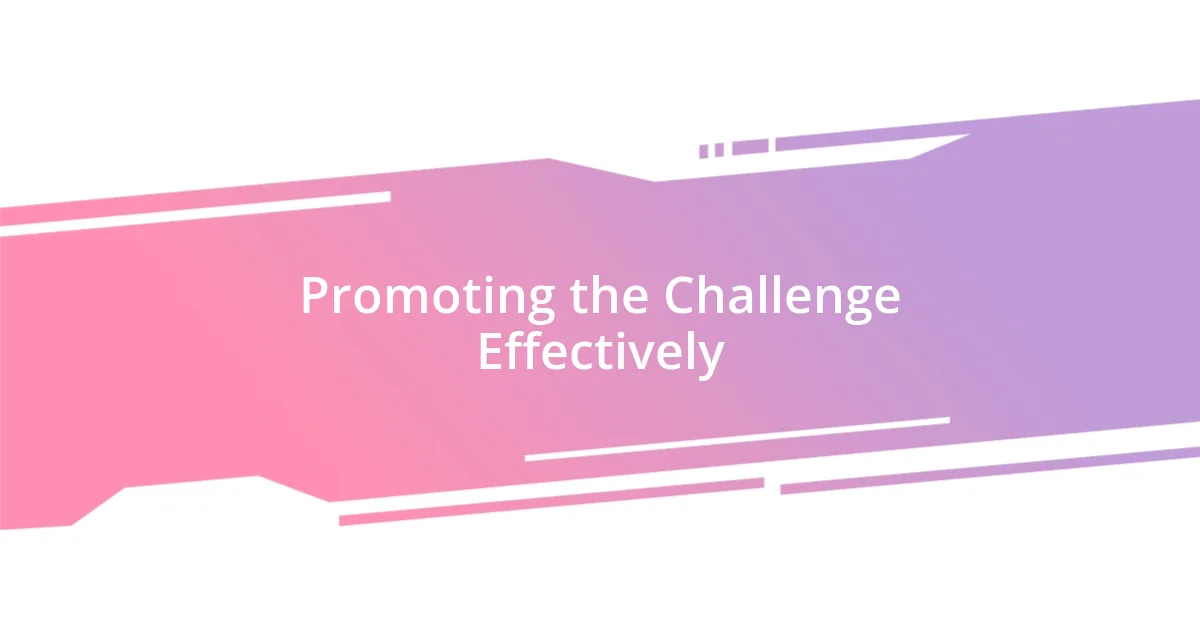
Promoting the Challenge Effectively
To effectively promote the sustainable fashion challenge, utilizing social media platforms became crucial for me. I crafted engaging posts that shared my journey, showcasing before-and-after photos of upcycled items and stylish outfits created from my existing wardrobe. Have you ever noticed how a visual story can draw people in? I found that sharing this transformation not only inspired my followers but also encouraged them to join in and try their hand at sustainable fashion themselves.
Another strategy that worked wonders was collaborating with local influencers who shared my passion for sustainability. I remember reaching out to a couple of eco-conscious bloggers, and we teamed up for workshops and online events. The excitement we generated was palpable as we exchanged ideas and broadened our reach. It dawned on me how collaboration can amplify voices and create a supportive network in such an important cause. Have you ever experienced the power of community when working toward a common goal?
Lastly, I organized a virtual kickoff event that included a live Q&A session about sustainable fashion choices. It was refreshing to interact with attendees, hearing their concerns and sharing insights. The energy in the room, albeit virtual, was contagious as we inspired one another to take actionable steps. What could be more fulfilling than sharing knowledge and fostering a network of like-minded individuals? I found that providing a platform for discussion led to deeper connections and a greater commitment to the challenge.
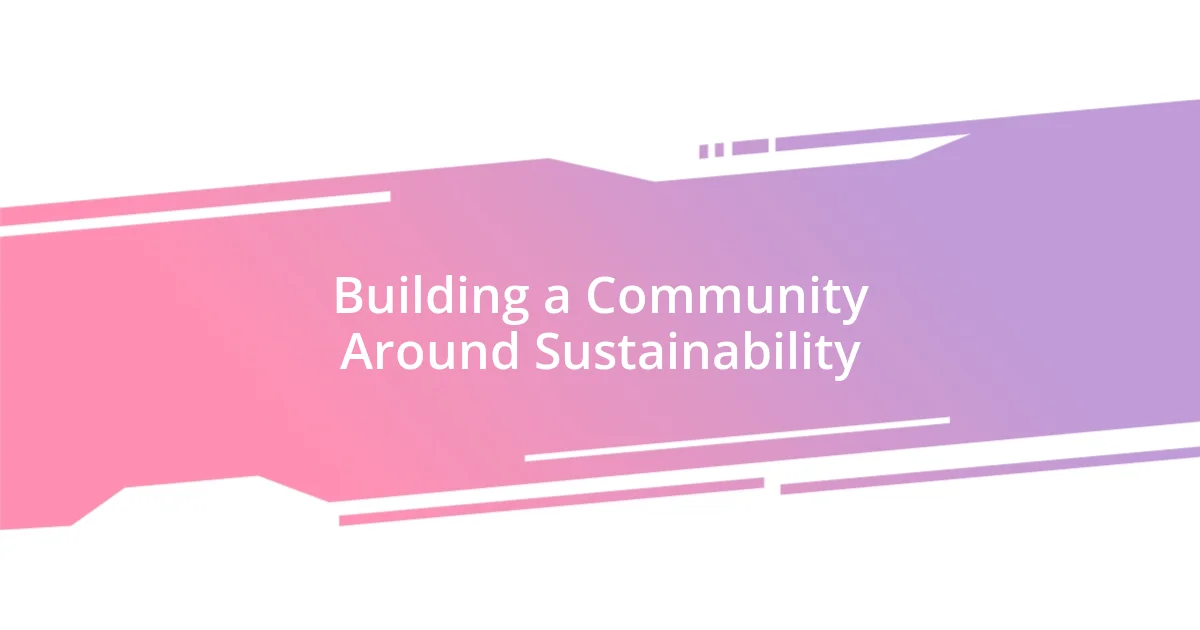
Building a Community Around Sustainability
Building a community around sustainability was one of the most rewarding aspects of my journey. When I first connected with others who shared similar values, it felt like finding my tribe. I remember the thrill of organizing a local meet-up where we swapped clothes and stories. Have you ever watched someone’s face light up when they find that perfect piece? It was those shared experiences that nurtured friendships and strengthened our commitment to sustainable fashion.
I also discovered the power of storytelling within this community. One evening, over coffee, I listened to someone’s heartfelt story about how they transformed their grandmother’s vintage outfits into something new and modern. That moment stuck with me; it reminded me how fashion is interwoven with our personal histories. It made me question: how often do we consider the stories behind the pieces we wear? By sharing these narratives, we not only bonded over sustainability but also celebrated each other’s creativity and heritage.
Engaging in meaningful discussions helped deepen our understanding of sustainable practices. I recall a spirited debate about the impact of fast fashion, where everyone contributed their viewpoints. It was stimulating to hear different perspectives, and it sparked a commitment to make deliberate choices. How enriching is it to be part of a dialogue where every voice matters? By fostering a safe space for these conversations, we built a community that is not just about fashion choices but also about collective growth and responsibility.


